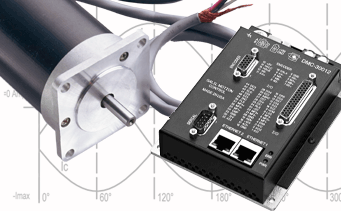To get news about Galil in the market, read our quarterly newsletter called ServoTrends, or our monthly newsletter called What's New At Galil review our Press Releases or go to your favorite technical on-line or print publication such as Design News, Machine Design, Design World, Control Engineering, and more.
Key Benefits of Galil High Performance Controller & Drive Products
A common shortcut with single axis controller/drive combinations is to use a single control loop (and processor) to handle both the Position Control Loop (ie: PID loop) and the Amplifier Current loop. Galil separates these two loops onto different hardware and therefore optimizes each of them for the highest system performance. For instance, on the DMC-30012 and -D3540 sinusoidal amplifiers, the current loop is closed at a 33kHz sample rate that gives a fast response and tight control of the current going to the motor. It allows a high closed loop frequency response of 3-4kHz. This frees the controller processor for closing the position loop as well as running programs and processing commands. This two-loop architecture allows Galil to be extremely responsive and highly accurate on many different types of servo systems.
Using Notch Filters to Compensate for Resonance in Servo Motor Control Systems
Servo motor control systems with resonance often create difficult problems for designers because it causes the servo control system to over-shoot and oscillate.
An effective way to compensate for resonance in a servo system is the use of a notch filter in addition to the standard PID servo loop compensation. To understand the operation of a notch filter, note that every resonance is characterized by two parameters: the imaginary and the real part. The imaginary part sets the resonance frequency, whereas the real part sets the damping. The smaller the real part, the stronger the effect of the resonance.
Servo Amplifier Types - Linear and Pulse Width Modulated (PWM)
/* Style Definitions */ table.MsoNormalTable {mso-style-name:"Table Normal"; mso-tstyle-rowband-size:0; mso-tstyle-colband-size:0; mso-style-noshow:yes; mso-style-parent:""; mso-padding-alt:0in 5.4pt 0in 5.4pt; mso-para-margin:0in; mso-para-margin-bottom:.0001pt; mso-pagination:widow-orphan; font-size:10.0pt; font-family:"Times New Roman";}
This post describes two types of servo amplifiers used to drive DC and brushless DC servo motors: linear and pulse-width-modulated (PWM) servo amplifiers.
Linear servo amplifiers apply the full voltage across the power transistors which results in high power dissipation and higher heating. For this reason, linear servo amplifiers are typically used in applications requiring less than 100 watts or when switching cannot be tolerated in applications. PWM servo amplifiers switch the voltage across the power transistors off-and-on so that the required average voltage is achieved. This results in less power dissipation and more efficiency making PWM servo amplifiers much more common than linear amplifiers.
Minimizing Servo Motor Temperature in Optimal Design of Motor Control Systems
st1\:*{behavior:url(#ieooui) }
/* Style Definitions */ table.MsoNormalTable {mso-style-name:"Table Normal"; mso-tstyle-rowband-size:0; mso-tstyle-colband-size:0; mso-style-noshow:yes; mso-style-parent:""; mso-padding-alt:0in 5.4pt 0in 5.4pt; mso-para-margin:0in; mso-para-margin-bottom:.0001pt; mso-pagination:widow-orphan; font-size:10.0pt; font-family:"Times New Roman";}
The ability of a servo motor to perform the required moves within short times is limited by the temperature rise that results from the power dissipation. It follows, then, that the optimal design of a servo motor control system, which maximizes the system throughput, is the one that results in minimum servo motor temperature.
This post addresses the optimal design of a servo motor control system. It assumes a required motion of given length, and seeks the design that accomplishes the required move within a specified time, while minimizing the servo motor temperature.


